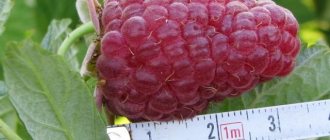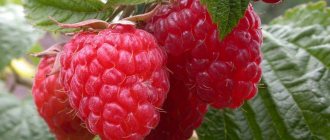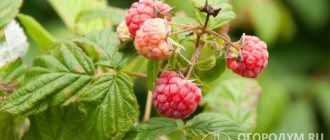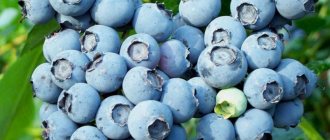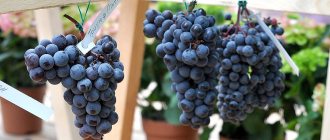Raspberry variety Skazka (Raspberry tree Skazka) is the newest standard raspberry variety, which is a variety of the tree-like Tarusa raspberry, popular among gardeners. In this article, you will get to know this amazing variety better, learn the features of planting raspberry trees of the Skazka variety, the basic principles of caring for plants, methods of propagating them, and you will also be able to read reviews from gardeners and admire photographs of fruit-bearing bushes.
Raspberry Skazka: description of an unusual variety, reviews from gardeners, photos, how to plant, care rules
Every year, new seedlings of berry crops appear on sale, which are distinguished by improved characteristics and large berry sizes. But completely new varieties of berry bushes that are already familiar to gardeners are also appearing, which, despite their novelty, are already gaining popularity among gardeners and summer residents.
One of these new products is the raspberry tree. And new varieties of this plant have already appeared, one of the best of which is Skazka
. The main characteristics of the variety, cultivation, further care, advantages and disadvantages of this raspberry tree will be discussed below.
The content of the article:
1. History of the creation of the variety 2. Description and characteristics of the variety 3. Skazka raspberry, remontant or regular 4. Frost resistance of the Skazka raspberry 5. Productivity of the variety 6. Growing and care 6.1 Planting the Skazka raspberry tree 6.2 Further care 6.3 Pruning the Skazka raspberry tree 6.4 Feeding the Skazka raspberry tree 7 Diseases and pests 8. Advantages and disadvantages of the variety 9. Reviews of the raspberry tree Fairy Tale
Diseases, pests and their control
The main danger is fungal diseases that appear with high air and soil humidity. In cool summers, raspberries require special attention. Common diseases and pests of the Skazka variety are in tables 2 and 3, respectively.
table 2
| Disease | Symptoms | How to fight? |
| Curly | The fruits are sour, the leaves are rolled into tubes. | The disease has no cure. Destruction of affected bushes. Treatment with Bordeaux mixture. |
| Anthracnose | Drying of flowers, shoots, tops of stems. The appearance of gray spots surrounded by a red border. | Planting healthy planting material. Every 10 days - spraying with Fundazol. |
| Gray rot | The berries are rotting and there are brown rings on the stems. | Affected areas are cut off and burned. Treat the bushes with Fundazol or Bordeaux mixture. |
| Rust | Gray ulcers bordered with red appear. The fruits are dark inside. | Similar to gray rot, as well as treatment with copper-containing preparations - for example, Bayleton. |
You can see what a raspberry bush affected by one disease or another looks like in this article.
It is recommended to destroy raspberry pests before they cause harm to the raspberry tree. To do this, standard preventive measures are carried out - loosening, spraying, etc.
Table 3
| Pests | Damage caused | How to fight? |
| Raspberry beetle | The larvae eat away the receptacle and spoil the berries. | During the budding period, cover the raspberries with non-woven material, and remove it after the flowers open. They also spray with tansy infusion - take 300 g of dry plant or 1 kg of fresh per 5 liters. |
| Raspberry stem fly | Shoots affected by larvae turn black and wither. | Damaged shoots are cut out and burned. The soil is loosened, destroying the larvae that go into it. Chemicals are not recommended. |
| Spider mite | Capable of destroying up to 70% of the crop. Leaves curl, turn yellow and fall off. | In spring, spray with 6-7% urea. For severe lesions - Fufanon - 10 ml per bucket. In autumn - Actellik (20 g per bucket). |
History of the variety's creation
Raspberry tree
appeared several decades ago.
However, there is no specific information about who developed the Skazka variety. But in some sources there was information that this standard variety was bred by Professor V.V. Kichina.
But in the works of this scientist there is no information about the development of the Skazka raspberry tree variety.
Photo of the appearance of raspberries
Therefore, gardeners who are planning to grow this berry bush in their garden need to know that this variety does not officially exist, since Skazka raspberries are
was not entered. Therefore, there is a great risk of purchasing raspberry varieties that are only similar in appearance to the Skazka raspberry tree, but in fact have nothing in common with this berry bush.
Reviews from gardeners:
“For 25 years now I have been growing raspberries on my 5 acres in the Moscow region. Basically, my bed consists of the Novost Kuzmina variety, which I consider very good and time-tested, but there are also several Skazka raspberry bushes on it. My son brought it to me in 2015 with the words “Dad, stop planting simple raspberries, here’s a raspberry tree for you.” To be honest, I doubted that something worthwhile would come out of this idea, but after trying the first berries a year later, I want to say that the variety is very worthy. Skazka is a large-fruited variety, and most importantly tasty, and in terms of yield it surpasses the varieties that I planted before, including raspberries. News Kuzmina"
Raspberry tree Fairy Tale: description and characteristics of the variety
Since this variety is not listed in the State Register and there is no official standard for Skazka raspberries
The description and characteristics of this berry bush, presented below, are compiled according to the descriptions of the sellers and gardeners who grew these raspberries:
- The variety is high-yielding, the berries are large-fruited, with an average ripening period.
- The fruits
are bright red in color, shiny, elongated conical in shape, with dense drupes. - The harvested crop has a universal purpose - the berries are consumed fresh, compotes are boiled, jams and jams are prepared, and they are frozen.
Characteristics of the raspberry tree Fairy Tale - video
fruit Fairy Tale
They are quite dense and can withstand transportation well over long distances.
Taste qualities of ripe berries
- typical for raspberries, they have the aroma characteristic of this berry.
The bushes of the Skazka raspberry tree are quite tall, the shoots can reach 1.6-3.1 m in height, the shoots are strong, sufficiently thick, erect, and have practically no thorns. But replacement shoots are formed in small quantities. Gardeners confirm that the data on the appearance of the bushes is practically confirmed.
Photo of raspberry tree bushes Fairy Tale
The size of the Skazka shrub directly depends on the climate of the growing region and the quality of the soil. Powerful stems do not lie down even under the weight of the crop, so they do not need tying or support. No root shoots are formed, the rhizomes are compact, so there is no need to cut out excess shoots.
Interesting!
Judging by the description provided, the Skazka variety is very similar to Tarusa raspberries in terms of basic characteristics, nuances of cultivation and care.
Characteristics of the standard variety
There are several important characteristics of the Skazka raspberry that a gardener should know about:
- It is a mid-season variety, so the first harvest can be obtained by mid-July. However, the berries ripen gradually, so you can enjoy the fruits until mid-August.
- The shoots are dense and woody, which is why this variety is often called “Raspberry Tree”.
- Large fruits. The average weight is 10 g, but individual berries can weigh 15 g.
- High sugar content in berries. However, with insufficient sun or improper watering, slight sourness may occur.
- The fruits do not fall off after ripening. They are easy to separate from the stalk and transport.
- On each stem you can find 4–6 side shoots. They create fruit branches.
- Productivity is up to 10 kg per bush, which is a very high indicator.
- Raspberry Skazka tolerates diseases well and is rarely attacked by pests.
- Good frost resistance.
Important. This raspberry variety must be pruned. The bushes need to be shaped so that there is no excessive number of shoots. Otherwise, the root system will absorb large amounts of minerals from the soil for growth. That is, there will be practically nothing left for the formation of berries.
Raspberry Fairy tale remontant or ordinary?
Some traders claim that the Skazka raspberry variety is remontant
, while others say that there are two varieties of this berry:
regular and remontant.
But this statement is not true, since raspberry varieties with thick shoots are not remontant, because their fruits are set on last year’s shoots. Therefore, such statements from sellers are an advertising ploy, nothing more.
Most often, ordinary standard varieties of this berry are sold under the guise of Skazka raspberry trees.
This shrub cannot exist as a tree, as this contradicts the biological description of this berry plant.
Of course, it is possible to grow such standard shrubs, but this is not related to its qualities as a “raspberry tree” type variety. Thick berry bushes do not need tying, do not require supports, they are easier to prune, but in order to maintain the appropriate appearance of this standard bush, a wealth of experience in caring for other varieties of raspberries is required. Therefore, it is better to grow the Skazka variety only for experienced gardeners living in the southern regions of Russia.
Raspberry varieties!
• Diamond raspberry • Raspberry variety Eurasia
Description of bushes and berries
Brief botanical description of “Fairy Tales”:
- Bushes. Powerful, with thick, woody shoots. Height - 1.5-3 m. They can bear fruit without a garter - thick shoots do not bend to the ground, withstanding the weight of the harvest.
- Fruit. Large, shiny berries weighing from 8 to 15 g. Color – bright red. The shape is elongated-conical.
The name “raspberry tree”, often used by sellers to refer to standard varieties, is associated only with the similarity of the crown of the bush with the crown of a tree, nothing more.
Frost resistance of raspberries Fairy Tale
Sellers claim that the Skazka raspberry variety is highly resistant to frost.
and does not require shelter even when the temperature drops to -28-30 degrees Celsius. However, in fact, Skazka raspberry bushes winter well only in the south of Russia. The problem is this: like all standard plants, the shoots of this variety become woody too quickly and become brittle. Therefore, it is difficult to guess the moment when the stems can be safely bent to the soil for further shelter for the winter. Therefore, most gardeners fail to carry out covering work and this raspberry tree remains uncovered for the winter. As a result, all parts of the Skazka shoots that are above the snow cover freeze out. Therefore, next season the yield of these berries drops sharply.
Features of growing standard raspberries
Firstly, to grow standard raspberries you need full daylight sunlight, which can be achieved by placing rows of raspberry bushes when planting from south to north in your garden plot.
- The growing soil must be well-drained and fertile;
- soil fertility is formed no later than 1 month before planting, when 2 buckets of humus, 150 grams of nitroammophoska and a glass of ash per 1 linear meter are added to the prepared landing strip, 60 centimeters wide. It is recommended to dig up such soil by 1 bayonet with a shovel or motor cultivator;
- best planting time: from mid-September to late autumn; in spring - from early March to late April, and during mild winters in the southern regions - even in winter;
- When planting, the bushes are placed in one line with an interval of 50 centimeters. Add 1 tablespoon of nitroammophoska to the planting hole.
Pay your attention to the roots of the seedlings - they must be covered with earth so that the root collar is deepened no more than 2-3 centimeters, cutting off the shoots to 25-30 centimeters. Water the soil around the seedling at the rate of 5 liters per bush, mulch with humus.
Planting a Raspberry Tree Fairy Tale
The soil should be sufficiently loose and fertile; stagnation of moisture in the soil can cause root rot in shrubs and other diseases. The pH of the soil should be slightly acidic or neutral.
Immediately before planting Skazka raspberry bushes, humus or compost and complex mineral fertilizers are added to the soil. The presence of fertilizers will have a positive effect on the yield of this berry bush. It is better to plant raspberries in trenches with good drainage at the bottom.
Cherry variety!
• Cherry Chocolate Girl
Landing
There are no special requirements for agricultural technology for planting standard raspberry varieties. Planting is carried out in the spring (April) or autumn (September-October), but, according to experts, spring planting is more preferable. If we have time to plant before the buds open, we will get excellent survival and fruiting of raspberries the very next year. The planting location has a significant influence on the further development and fruiting of the variety. For Skazka raspberry trees, choose sunny, windless areas with loose, nutritious soil.
You might be interested! The most popular variety of yellow raspberries is the Yellow Giant.
Planting methods:
- into the hole. For each plant, a separate hole measuring 0.5 x 0.5 m and a depth of 0.4 m is dug, the distance between plants is approximately 1 m, between rows 1.7-2.0 m.
- into the trench. A single trench is dug for a row of raspberries. The width of the trench is 0.5 m, the distance between plants in a row is 0.5-0.7 m, the distance between trenches is 2.0 m. The depth of the trench is 0.4 - 0.5 m.
Any of the presented methods is chosen only based on the gardener’s preferences; there are no significant differences in the results between them, but from the point of view of the amount of fertilizer required, fertilizing in the hole is more economical, because in the case of a trench, it is necessary to fertilize the soil along its entire length, and in the hole only directly in the area of the root system of the bush.
It is advisable to add rotted manure or compost to the bottom of the hole or trench, and add peat, ash, and sand to the upper layers of the soil.
Further care
This standard crop requires special care, without which you may not get a good harvest. In the spring, the soil around the bushes is loosened with a pitchfork, and after digging, a layer of mulch at least 8-9 cm thick is laid in the tree trunk circles. Peat, humus or straw can be used as a mulching element.
Raspberries of the Skazka variety, although they do not like stagnant moisture in the soil, are extremely necessary for watering. Therefore, every 5-7 days, add at least 10 liters of water at room temperature to each bush. It is especially important to monitor soil moisture during flowering and fruiting.
Planting and care
There is no particular difference in growing the standard Skazka raspberry: this variety requires the same agrotechnical techniques as any other garden or remontant raspberry. For a good harvest, Skazka raspberries need loose soil, regular watering, generous fertilizing, a lot of sun and warmth.
Important! Still, standard raspberries require more frequent attention from the gardener. But one Fairy Tale bush will produce as much harvest as ten bushes of the regular variety.
How to plant Fairy Tale in your garden
Raspberries, which are standard varieties, require a lot of space and light - this is the first rule for planting such a plant. That is why for this raspberry they choose a sunny place protected from the wind, preferably located on a hill.
The soil under Skazka should be loose and nutritious, so if it does not meet these requirements, the composition of the soil will have to be improved. After digging a hole for planting a seedling, fill it with nutritious black soil or add a bucket of humus, coarse sand, wood ash, and peat.
For standard raspberries, good soil breathability is very important, since the upper roots of such a plant must absorb oxygen from the air. Therefore, Skazka is not planted in lowlands, where water will stagnate in spring or after heavy rain. In addition, the soil around the bush is regularly weeded, loosened and weeds removed.
Advice! You should buy seedlings of such valuable varieties as standard Skazka only from trusted nurseries.
This raspberry is propagated by cuttings. They need to be planted immediately after purchase. If there are several bushes, a decent interval is maintained between them - 100 cm in a row and at least 180 cm between adjacent rows.
To plant a Fairy Tale seedling, dig a hole or trench, the depth of which will be about 40 cm. Humus or compost is poured into the bottom of the bed, and the upper layers of soil are mixed with ash, peat, and sand.
After planting, raspberries need to be watered regularly until the roots take root and new shoots appear on the stem.
You need to care for standard raspberries constantly, almost all year round. This care consists of the following:
- After the seedlings take root, watering is done less frequently as the soil dries out.
- When new leaves begin to appear, the soil around the Skazka is mulched with peat, sawdust or leaves to better retain moisture.
- When the bush blooms and the berries ripen on it, raspberries especially urgently need watering. During this period, Skazka is watered more often and more abundantly.
- Standard raspberries need to be fed from the beginning of flowering until autumn pruning. For feeding, it is better to use liquid organic matter or mineral complexes dissolved in water.
- After harvesting, in the fall it is necessary to prune the bush. At this stage, two-year-old shoots are cut out at the root and a bush is formed, leaving no more than seven young stems. New replacement shoots should be distributed evenly.
- If the autumn is dry, in October you definitely need to water each Fairy Tale bush abundantly. In addition, the raspberries should be fed: four buckets of cow manure are placed under each plant, and fertilizer is sprinkled with sawdust on top.
- Preparing raspberries for winter involves tying up the still green shoots and bending them lightly to the ground. After this, the associated shoots are fixed at the base of a neighboring bush (this is possible if the Fairy Tale is planted at the correct interval).
Attention! In the spring, there is no need to feed Skazka with nitrogenous fertilizers, this will lead to the growth of unnecessary shoots and reduce productivity.
To grow a standard variety in Siberia, you need to give preference to the remontant variety Skazka. During autumn pruning, such raspberries are removed at the root, cutting out absolutely all shoots. Then all that remains is to cover the ground to protect the roots of the plant.
In the middle zone, it is convenient to use not the method of bending raspberries (since it is difficult to do due to the thick stems), but covering the tops of the plants with reed mats or non-woven material.
Propagation of standard raspberries
The Skazka variety does not need unnecessary advertising, since the beauty of the bushes and the size of the berries are responsible for its popularity. It is not surprising that an increasing number of gardeners dream of having these raspberries in their own garden. But the standard variety does not reproduce very well.
Important! Reproduction of Skazka is complicated by the small number of replacement shoots - there are significantly fewer of them than in conventional varieties. But standard raspberries will not “spread” around the area, filling all the free space.
You can reproduce the Fairy Tale in several ways:
- root cuttings;
- green cuttings - shoots;
- root suckers.
It is best to plant standard raspberries in October, when the seedlings are fully mature.
In special laboratories, similar raspberry varieties are propagated using the microclonal method; this is much cheaper and significantly increases the number of healthy seedlings.
Pruning a raspberry tree Fairy Tale
The pruning procedure is carried out in order to remove old, diseased and damaged shoots. Some gardeners leave no more than one replacement shoot during the pruning process.
Pruning raspberries - video
In the last ten days of May or the first ten days of June, shoots more than a meter high are cut to 12-14 cm and by the end of summer, several side shoots are formed on each bush, which remain in the winter.
Useful article:
Rules for pruning raspberries in spring, summer, autumn, double pruning
Agricultural technology
To obtain a high-quality and abundant harvest of a new raspberry variety, it is necessary to select a good-quality seedling, prepare the place and, finally, competently carry out the planting of the bush itself.
Choosing a landing site
Successful planting of tree raspberries is guaranteed by an area protected from the winds and well illuminated by the sun's rays. To prevent the bushes from getting sick, the soil under the raspberry tree should have weak or neutral acidity.
The addition of lime or dolomite flour helps reduce this indicator. Also make sure that there is no groundwater close to the landing site. The roots of raspberry bushes respond negatively to excess moisture; they become wet and rot.
Selection of seedlings
Also pay attention to the foliage. Spots of gray, orange or brown on the leaf blades indicate that the seedling is sick.
The rhizome must be strong, not broken, without signs of rotting, from 15 cm in length. Try not to buy seedlings near the road.
Give preference to specialized retail outlets so as not to make a mistake when choosing the right variety. At the market, be sure to ask the seller for documents confirming the type of seedling.
Planting and care
The area for planting Skazka raspberries must be dug up to a depth of 30 cm in advance and freed from weeds.
Landing technique:
- Form depressions 50x50 cm, with a distance between them of at least 1 m and a minimum distance between rows of 1.7 m.
- Fill the bottom of the hole with rotted manure and superphosphate, sprinkle with fertile soil on top.
- Carefully straightening the roots, place the seedlings in the holes. Cover the root system with soil on top and compact it lightly. The transition zone between the root and the stem should be at ground level.
- Pour at least 5 liters of water under each seedling. As soon as the water is absorbed, fill the resulting depressions with a 10-centimeter layer of mulch (straw, hay, sawdust, moss or seed husks are suitable).
The standard is one of the most easy-to-maintain forms. Immediately after planting and until the first shoots appear, daily watering is required. In the future, 1 bucket of water per plant is enough.
For active growth and fruiting in the fall, garden crops are fertilized with rotted manure (3-4 buckets per plant). Manure can be replaced with peat and urea. In July, when the period of fruit ripening begins, organic matter or mineral fertilizers are added. Avoid nitrogen-containing products, they provoke active growth of excess growth.
Disease and pest control
Despite the immunity of the presented variety to most ailments that affect raspberries, for preventive purposes in the spring the bushes are treated with Bordeaux mixture. Before blooming begins, they are treated twice with a 3% solution with an interval of 2 weeks, and in May - with a 1% composition.
There are attacks by the raspberry beetle, the raspberry-strawberry weevil and others. The drug Actellik or its analogues will help get rid of them. During raspberry flowering, only biological products are used.
The stem fly poses a threat to plant life. From time to time it is necessary to inspect the stems for swelling. If you find them, immediately cut out the affected parts of the bush and burn them. The larvae of this parasite can overwinter in the top layer of soil; to prevent infection, all fallen leaves must be collected and burned.
Reproduction
The Skazka variety is difficult to breed. Reproduction is made difficult by the fact that the variety of shoots has significantly fewer replacements than ordinary raspberry varieties.
Fertilizing raspberries Fairy Tale
After the end of fruiting, rotted manure (about 30-40 kg for each bush) should be added under these standard raspberry bushes. Instead of manure, you can use a mixture of urea and peat.
Important!
You should not get carried away with applying large amounts of fertilizers with nitrogen - such fertilizing only increases the number of side shoots on which berries do not grow.
Also, these bushes require a large amount of nutrients during the period of active fruit ripening, so in the last ten days of June - the first ten days of July, raspberries are fertilized with organic and mineral fertilizers, which are applied alternately.
Raspberry care
Procedure for caring for standard raspberries:
- Watering. The maximum frequency of watering is once a week. The exception is the first week after planting and extreme heat. Water raspberries in the morning or evening so that the water penetrates the soil and does not evaporate.
- Feeding. In spring, the bushes are watered with a solution of nitroammophoska - 20 g per 10 liters. Until mid-July, add an infusion of weeds or liquid mullein (1:10). From the second half of summer, organic matter is not added, as it contains nitrogen, which stimulates shoot growth. At the end of August, autumn mineral fertilizers are applied - the manufacturer labels them “autumn”. Or water it with potassium salt/superphosphate, diluted in a bucket of water, 10 and 20 g, respectively.
- Loosening . In summer, weeds are periodically pulled out and the soil is loosened. It is also recommended to hill up the bushes. It is recommended to do this work in May and autumn, after harvesting.
- Mulching. The soil, sprinkled with a 5-7 cm layer of mulch, retains moisture well and prevents weeds from growing. Suitable mulch is peat, humus, straw.
Diseases and pests
Since there is no exact information about the resistance of this raspberry to diseases and attacks by pests, therefore in the spring after the snow melts, raspberry bushes should be treated with fungicidal preparations. These products prevent the occurrence of various types of rot, rust and many other diseases. You can also treat the shoots with Bordeaux mixture. This preventive procedure is repeated in mid-autumn, after the leaves of the bush have fallen.
Photos of pruning and processing raspberries
Trimming
Special attention should be paid to pruning Skazka raspberries. It is carried out in several stages. When preparing a plantation for future wintering, in the fall, after the harvest is completed, it is necessary to cut out adult two-year-old plants almost at the root. Next, it is important to inspect the young shoots and leave only the strongest annual shoots in an amount of no more than 5 or 7 per bush.
In spring, shoots are shortened at the beginning of summer when they grow to a meter. Trim the top part by about 10 cm. This pruning will help the bush form up to 5 side branches, on which the plant will lay an additional harvest. Without performing these works, it is impossible to achieve maximum productivity from Skazka. It is also important to prune in time so that the newly grown young branches have time to form and not freeze out in the winter.
Advantages and disadvantages of the variety
Traders and gardeners include the main advantages of the Skazka raspberry tree:
- strong, powerful shoots that do not require garter or strong supports;
- good yield;
- large fruits with good taste;
- good transportability of the harvested crop;
- excellent presentation of ripe fruits;
- versatility of using ripe berries.
The main disadvantages of the Skazka variety include low resistance to frost.
, therefore it is not recommended to grow it in regions with cold winters.
Raspberry tree Fairy Tale: reviews from those who planted
There are quite a large number of reviews from gardeners about the “raspberry tree” Fairy Tale
, some of which are listed below.
Natalya, 40 years old, Ryazan:
“A seller at the seedling market persuaded me to buy a “raspberry tree” of the Skazka variety; he said that it was a frost-resistant, high-yielding variety that could be grown in our region. I believed it and purchased several seedlings (by the way, quite expensive ones). The variety turned out to be non-remontant, as the seller said, the fruits were formed on the shoots of the second season. The taste of the fruit is excellent, you can’t complain about it. But covering it for the winter is quite difficult, since I tried to bend the shoots to the ground, but they turned out to be lignified and very brittle. As a result, these bushes have to spend the winter without shelter; as a result, the upper parts of the shoots with flower buds freeze out over the winter, so the yield of my Skazka raspberries is very poor. We had to later abandon this variety and replace it with other more unpretentious and high-yielding raspberry varieties.”
Elena, 39 years old, Labinsk:
“In my garden, this standard variety grows well, bears fruit and overwinters without shelter, without freezing. I think this is because winters in our region are warm and mild. But the yield is slightly lower than what is stated by the seller. And so I am satisfied with the large-fruited variety, the taste of the berries and their versatility.”
We can say that the Skazka raspberry
quite ambiguous, its characteristics are also questioned by gardeners. But in the southern regions of Russia, the Skazka raspberry shows good results in terms of yield and does not freeze, so in these areas you can find this berry standard shrub in many garden plots.
Reviews from gardeners
Marina, 39 years old, Moscow region
I kept this “Fairy Tale” on the site for four years, and was forced to abandon it completely. The berries are, of course, large and sweet. Dense, can be frozen and transported. But there are a lot of difficulties, even if you don’t try to form bushes on trunks. In the first winter after planting, I left the bushes without shelter (I believed that they were winter-hardy). Spring came, and I realized that they were all frozen above the level of the snow cover, that is, those parts of the stems on which flowers should have appeared were damaged. There was almost no harvest. In the fall, I cut out all the “fruit-bearing” stems, and decided to bend down the annual ones. It turned out that it is very difficult to understand at what time the shoots need to be covered. If they don’t have time to ripen, they may not survive the winter or get sick; if they do, they will become brittle and impossible to bend. In general, there is a lot of fuss, but the result is questionable. There are raspberries with equally large and tasty berries, but without such problems. This variety is more likely for warmer regions.
Alexander, 44 years old, Saratov
Not a bad variety. It has been growing for me for several years now and overwinters without shelter. There were no difficulties with planting and caring for them. I like that there is no need to create a trellis, there are practically no thorns and little growth is formed. True, regarding the “raspberry tree” it turned out to be a complete deception. The Skazka variety does not grow in this form, and indeed there are no such raspberries. I made a couple of bushes on trunks. Not very difficult, but the shape must be maintained all the time and additional pruning must be done. It turns out beautifully, but does not affect the yield in any way. In general, ordinary good raspberries, no better or worse than other modern varieties.
